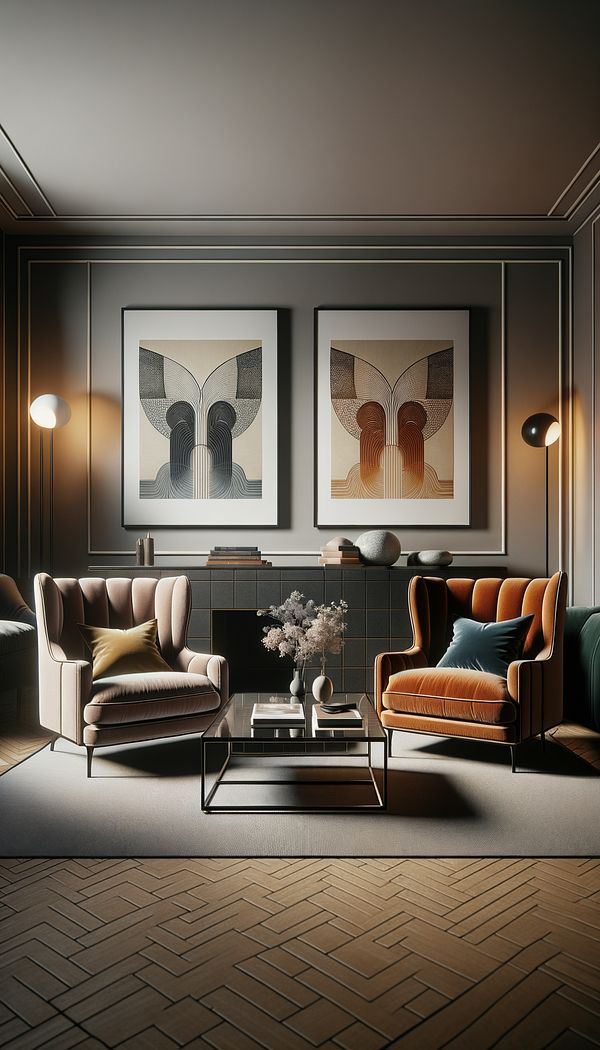What is Vis-A-Vis?
Vis-à-vis in interior design refers to furniture or objects facing each other.
Description
In the realm of interior design, the term "vis-à-vis" takes on a unique meaning, different from its traditional use in language. Stemming from French origins, essentially meaning "face to face," vis-à-vis in design typically refers to how furniture or objects are placed in a space relative to each other. It is a concept that focuses on the positioning and orientation of items within an interior, often aiming to facilitate conversation, interaction, or simply to create a balanced and harmonious arrangement.
When applying the vis-à-vis principle, designers might position two armchairs opposite each other with a small coffee table in between, creating a perfect setting for a chat or a relaxed reading session. This method can also be utilized in larger groups of furniture, ensuring that items are placed in a way that encourages social interactions and visually appeals. The concept doesn't only apply to seating arrangements - it can also influence how decorative elements, artwork, or even lighting fixtures are positioned in relation to each other to create a cohesive and engaging interior environment.
The importance of vis-à-vis arrangements cannot be overstated in interior design. It contributes significantly to the functionality of a space, determining how people will move within and interact with the environment. It also has a considerable impact on the aesthetic appeal, assisting in creating visually balanced and inviting interiors.
Usage
An example of vis-à-vis in use would be a living room layout where a sofa faces two armchairs with a coffee table in between. This arrangement fosters a social atmosphere conducive to conversation. Designers might also apply the vis-à-vis principle to dining room settings, where chairs are strategically positioned around a table to encourage interaction among diners.
FAQs
-
Does vis-à-vis only apply to furniture?
No, while vis-à-vis is often associated with furniture arrangements, the concept can also apply to the placement of decorative items, artwork, and even lighting fixtures in a room to create harmonious and engaging spaces.
-
Can vis-à-vis be applied to any design style?
Yes, the vis-à-vis principle is versatile and can be applied across a variety of design styles, from traditional to contemporary, to enhance the functionality and aesthetic appeal of a space.
-
How does vis-à-vis impact room functionality?
Vis-à-vis arrangements can significantly influence how people interact within a space, promoting conversation and social interactions, as well as how they navigate the room, emphasizing ease of movement and accessibility.
Practical Application
When you're looking to apply the vis-à-vis principle in your own space, start by thinking about the primary function of the room. Are you aiming to create a social hub for family and friends or a quiet reading nook? Once you've determined the purpose, consider the placement of key pieces of furniture like sofas and armchairs to face each other, creating inviting areas for interaction. Remember also to apply this principle to other elements in the room, like lighting fixtures and artwork, to achieve a balanced and cohesive interior design.
-
Design Styles478 articles
-
Furniture Types599 articles
-
Space Planning & Layout134 articles
-
Decorating Principles & Elements330 articles
-
Bench SeatA bench seat is a long, fixed seat designed for multiple people.
-
Pickled FinishA pickled finish is a treatment applied to wood that lightens its color and enhances its grain.
-
Vis-A-VisVis-à-vis in interior design refers to furniture or objects facing each other.
-
SilhouetteThe outline or general shape of an object.
-
Log FurnitureLog furniture is furniture made from whole or partially whole logs.
